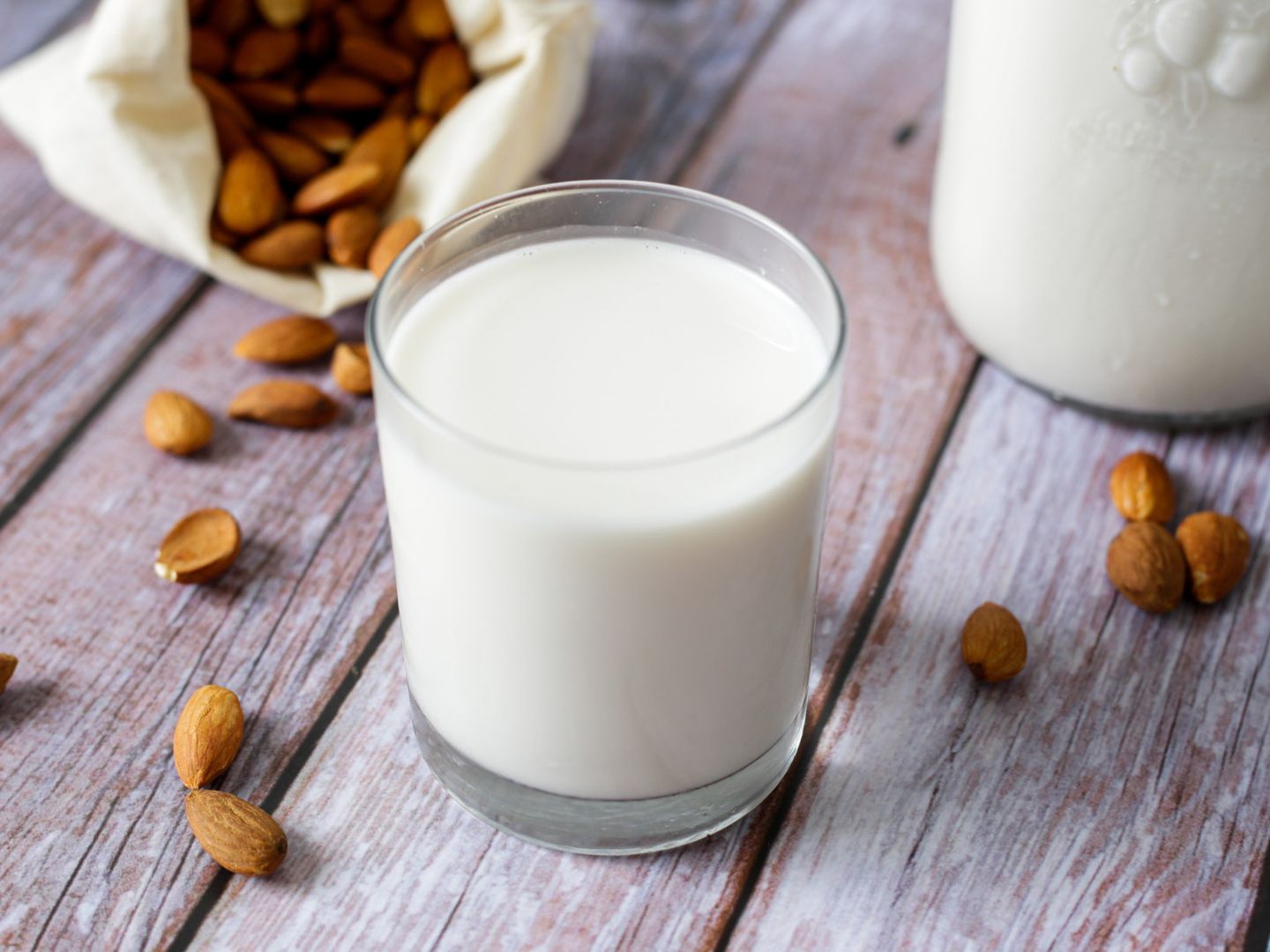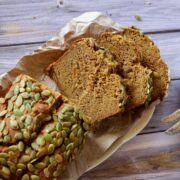Making your own homemade almond milk is as easy as 1, 2, 3 and saves heaps of money and rubbish! Also, it’s completely natural, without any additives or hidden nasties!

Three ingredients are all you need: almonds, water and salt! That’s it, you may ask. Yup, that’s all you need and with my few little tips and tricks, I’m sure you’re gonna love making your own almond milk!
Contents
I’ve been making my own homemade almond milk for years now and have been experimenting a lot until I found the perfect recipe which I will be sharing here with you!
This post is a beginner-friendly guide to homemade nut milk making that tells you which equipment is best, how to make it and what to do with almond pulp (your leftovers)!
So, let’s get started. Let’s milk that almond cow!

Ingredients
Affiliate Disclaimer: This article contains affiliate links. That means I may earn a small commission, if you purchase the linked product, at no extra cost for you.
- almonds (soaked for 12 hours)
- filtered water
- salt
I know, some homemade almond milk recipes use much more almonds than I do but trust me, you only need this little. Years of experience, guys!
Almonds: I prefer using organic almonds if I can. But that’s just a preference, not a necessity. Most important is that they’re raw and unsalted.
Water: Your water quality does matter. If your water’s smelling like a swimming pool from all that chlorine in it, filter it first, or buy filtered water. Otherwise, you’ll taste those chemicals in your milk, yuk!
Salt: Adding salt is technically optional but it does add more flavour. It simply does. Period.
Instructions
Making your own almond milk has several steps and might need a bit of planning ahead. I always recommend soaking the almonds first, before you make the milk. Here’s why:
Soaking Almonds for Almond Milk
We are soaking the almonds for our homemade almond milk for two reasons. One is to make them softer, so they’ll be easier to blend and extract. And the other one is to activate the almonds.
What? Activate? Let me explain: Nuts contain anti-nutrients like phytic acids that block the absorption of essential minerals for our body.
Soaking activates (hence the name activating) the sprouting process which reduces the amounts of anti-nutrients in the almonds. This makes them more nutritious for us.
- The soaking procedure is very easy. You simply put the raw almonds into a bowl, add water (enough to cover them) and add about 1 teaspoon of salt per 250ml/1 cup of water.
- Soak the almonds for 8-24 hours. I usually aim for 12 hours and soak them overnight. So, while I make dinner around 7 pm, I put them on and in the morning around 7 am, I make my almond milk.
How to make almond milk
Step One. Soak the almonds as instructed above. After 8-12 hours, drain and rinse the soaked almonds thoroughly.
Step Two. Then, you add them to your high-speed blender (for other options, see “equipment”). Add water and salt and blend for about a minute.
While blending prepare a large measuring jug that can hold at least 1 litre / 4 cups of liquids. Line it with your nut milk bag (see options below, “equipment”).
Step Three. Pour the blended almond milk through your nut milk bag into the jug. Now, you need to squeeze it—squeeze the bag until no more liquid comes out.
Step Four. Pour your homemade almond milk into a big jar or bottle and refrigerate. Put the almond pulp (the almond leftovers) into a container for later use, or make something right away (I’ll give you some ideas below).
Why should I make my own almond milk?
The most important question, isn’t it?? Well, store-bought almond milk is often sugary, enriched with supplements, and full of additives, and artificial flavours. Really nothing you wanna put into your body, right?
Even organic brands aren't ideal. Yes, most of them also just use water, almonds, salt and maybe vegetable oil, but check out the number of almonds they (and other non-organic brands) put in their almond milk... 2.5-3%??
Like, excuse me? So, you're actually buying water with a hint of almond. No wonder, the price is as low as 2-3$/litre.
And yet, making your own almond milk might actually save you some money (depending on how expensive your almonds are), plus it's got like 10% of almonds, and not only 3%.

Substitutions
This almond milk recipe is technically a basic nut milk recipe too. Instead of almonds, you can use other nuts like macadamias (I’ve got a recipe for that here), hazelnuts, or even peanuts!
Equipment
Which blender to use for making homemade almond milk
Ideally, you use a high-speed blender like a NutriBullet, a Vitamix or a Thermomix. I'm using my NutriBullet and it works very well. I usually do it in 2 lots because the cup isn't big enough.
Affiliate Disclaimer: This article contains affiliate links. That means I may earn a small commission, if you purchase the linked product, at no extra cost for you.
If you only have a food processor, give it a go. No idea, if it works because I don't have one—but I'm sure it's fine. Because I also made it with a simple stick/immersion blender before.
The only thing is that it can't blend as well as a high-speed blender, but if it's your only option, try it out! You may need more almonds for this option because it won’t be able to extract as much almond flavour as a high-speed blender can.
Another great idea is the Almond Cow!! For all of you who would like to make your own but simply don’t have the time and energy.
This awesome appliance does everything for you! It’s very easy to use and it’s getting more and more popular due to its convenience!
Nut Milk Bag
When buying a nut milk bag (see other options below), make sure to buy cotton or hemp materials. Don’t go for those plastic, polyester ones!
Cotton and hemp are very durable and easy to clean (machine-washable). Mine is made from organic cotton and I’ve been using it now for at least 2 years.
How to make Almond Milk without a Nut Milk Bag?
You can also make almond milk without a nut milk bag. Go to your local OP/thrift shop (or a fabric shop) or go through your wardrobe.
Curtain fabric (Swiss voile) or even an old T-shirt are great alternatives! In fact, I used to use my reusable produce bag which the OP shop ladies made from an old fine mesh curtain.
But don’t worry, you don't have to sew—here is a great tutorial about how to make one without sewing!
Variations
How to make chocolate almond milk
When you make your almond milk, add 4-5 tablespoons of cacao (raw) or cocoa (processed) powder. To sweeten, add 6-8 large Medjool dates or 60ml / ¼ cup maple syrup.
How to make vanilla almond milk
This is actually one of my favourites! It’s so simple but adds that certain twist to your homemade almond milk!
In Step One of this recipe, either add 1 vanilla pod (split and seeds scraped) or 1 teaspoon of vanilla essence.

Storage
How to store homemade almond milk
Ideally, you store your homemade almond milk in a clean (sterilised) 1 litre / 1-quart glass bottle. Super duper important to have it clean or your almond milk may spoil quicker!
You can reuse a large coconut oil jar for example, too, or even a measuring jug with a lid (that seals completely) will do.
Always keep your almond milk refrigerated! Or freeze it! Though I find after thawing, it lumps a bit or it just isn’t as smooth. But the taste is fine and not different.
How long does homemade almond milk last?
Your homemade almond milk lasts for about 3-5 days in the fridge. Sometimes even longer. Unfortunately, it does spoil fairly quickly.
I recommend making smaller batches if you don’t use much of it. Or you can also freeze for up to 3 months.
What to do with the almond pulp?
The only downside of making your own almond milk is the leftovers, aka almond pulp. It’s still food, so you don’t want to chuck it, but what to do with it??
There’s actually heaps that you can do with it (like cookies, energy balls, granola, etc.) and I will keep posting my recipe ideas, but for now, this is what I have:
- 3 ingredient peanut butter almond pulp cookies
- Almond Pulp Tahini Cookies
- coconut almond pulp snack balls
📖 Recipe
Equipment
- 1 high-speed blender see other options in the post
- 1 nut milk bag see other options in the post
Ingredients
- 70-80 g / (heaped) ½ cup almonds raw
- 1 L / 4 cups water + extra for soaking
- ¼ teaspoon salt
Instructions
- First, soak almonds for 8-12 hours (or simply overnight) in saltwater (mix 1 teaspoon salt with every 1 cup/250ml of water). The nuts have to be fully covered. Keep in mind that they'll grow a bit when soaking, so just add some extra water to keep them submerged.
- After soaking, drain and rinse almonds thoroughly.
- Add almonds together with 1L / 4 cups of water and salt to a high-speed blender and blend until smooth (about 1 minute).
- Place your nut milk bag (or your alternative, see useful tips below) over a large measuring jug or big bowl that can hold 1L / 4 cups of water. Strain Almond Milk through the bag and squeeze out all the liquid until only the almond pulp is left.
- Pour your Almond Milk into a glass bottle, jar or container of choice and keep in the fridge. Shake well before using!
Notes
- The Almond Milk keeps in a fridge for about 3-5 days (maybe longer).
- You can freeze it, too. That's what I usually do: I simply divide the batch into thirds, keeping one in the fridge and freeze the other 2. The Milk lumps a bit though and won't be as smooth. But the taste is alright

















Comments
No Comments